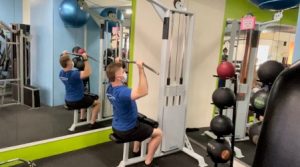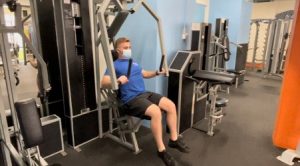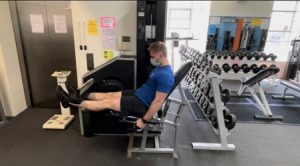“Gym Environment”- 6 machines you should be using
This week, Longevity Exercise Physiology discuss machines within the gym and various exercises to get moving. Our Exercise Physiologists at our Drummoyne, Edgecliff, Marrickville, Bella Vista, Randwick, Pymble, Balmain and Neutral Bay locations use machine weights in their exercise prescription to help our clients to achieve their goals.
Resistance training is crucial for keeping us fit, strong, injury free and healthy. It has a myriad of benefits for our health, including the prevention and management of disease and injury. The Australian Physical activity guidelines state that a minimum of 2x/week of resistance training is recommended.
Benefits of resistance training include but are not limited to[1]:
- Increased metabolic rate (due to increased muscle mass from resistance training)
- Functional benefits:
- Increased movement control
- Increased walking speed
- Increased independence
- Prevention of Type 2 Diabetes through:
- Reduction of visceral fat
- Reduced HbA1c levels (blood sugar)
- Improved insulin sensitivity
- Improved cardiovascular health
- Reducing resting blood pressure
- Decreasing low-density lipoprotein cholesterols and triglycerides
- Increase high-density lipoprotein cholesterol
- Increase bone mineral density (beneficial for osteopenia & osteoporosis)
- Reduction in pain in those with chronic pain & arthritic pain
- Health related quality of life (HRQOL)[2]
If you’re starting in the gym for the first time, and you feel comfortable with machines, here are 6 exercises that target majority of all the stationary movements. If I had to pick a handful to begin with, they would be these machines as they’re widely accessible and allow strengthening in majority of our major movement patterns.
Vertical Pull

Lat Pull Down
- Set up leg pad to allow it to anchor you comfortably
- Place your hands just outside shoulder width
- Take a seat and begin the movement by pulling the bar towards your collar bone, while bringing your shoulder blades towards the ground.
- During the pull, have your elbows pointing to the ground the entire time to prevent excessive pressure on the shoulder capsule or exhaustion of the wrists.
- Allow the bar to rise towards just before its starting position in a controlled motion, with shoulder blades rising towards the ceiling then repeat.
Horizontal Pull

Seated Row
- Set up chest pad to allow full extension of protraction of the shoulder blades.
- Take a seat and grab onto the handles.
- Initiate the exercise by pulling towards yourself, keeping wrists aligned with your forearms.
- While pulling, bring the shoulder blades together completely by the end of the movement.
- Bring the weight back to just before its starting position, allowing your shoulder blades to come away from each other, reaching extension of the elbow joint then repeat.
Vertical Push

Seated Shoulder Press
- Adjust the seat height so that resting position is at shoulder level.
- Grabbing onto the handles, pushing towards to the roof until full extension of the elbow joint.
- Allow the shoulder blades to move freely, however there is no need to rise the shoulder blades intentionally at the end of the movement to push the weight further.
- Lower the weight in a controlled manner back to just before its resting position and repeat
Horizonal Push

Seated Chest Press
- Adjust the seat height so that the handle height is in line with the middle of the chest. The horizontal starting position of the handles relies on two factors, the first is that the starting position is comfortable for your shoulders and then achieving as much range of motion as possible, with the maximum range being your fists almost lined up with your chest.
- Begin by squeezing and pulling (retraction + depression) the shoulder blades against the seat and keeping them in this position for the entire exercise.
- Start pushing the handles away from the body, keeping elbows just below the height of the hands.
- Once the elbows are fully extended, remember keep the shoulder blades in the same starting position, begin to bring the handles back to just before the starting position and repeat.
Knee Extension

Leg Extension
- Adjust the seat so that your knee position is in line with the axis of rotation of the machine. Secondly, adjust the shin pad so it is just above the ankle joint.
- Begin by extending your knees to full or as close to extension as possible, then lower the weight in a controlled manner to just before its resting position and repeat.
Knee Flexion

Hamstring Curl
- Adjust the seat so that your knee position is in line with the axis of rotation of the machine. Secondly, adjust the shin pad so it is just above the ankle joint.
- Begin by firstly pointing your toes towards your knees to reduce recruitment of the calves, then bring your heels towards your torso.
- Lower the weight in a controlled manner to just before resting position and repeat the movement.
If you’re looking to begin resistance training, or would like some help with your current regime, our Exercise Physiologists are experts in exercise prescription and want to help you!
As we venture into the new year, there’s no better time to start something new to kick off the year on the right foot. Call Longevity Exercise Physiology Edgecliff, Pymble, Marrickville, Randwick, Drummoyne, Balmain, Bella Vista and Neutral Bay on 1300 964 002 to enquire today.
Written by Guy Beynon
[1] Westcott, W. (2012). Resistance Training is Medicine. Current Sports Medicine Reports, 11(4), 209-216. doi: 10.1249/jsr.0b013e31825dabb8
[2] Hart, P. D., & Buck, D. J. (2019). The effect of resistance training on health-related quality of life in older adults: Systematic review and meta-analysis. Health promotion perspectives, 9(1), 1–12. https://doi.org/10.15171/hpp.2019.01
